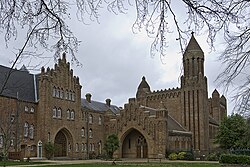Quarr Abbey
| Quarr Abbey | |
|---|---|
 Quarr Abbey |
|
| location |
|
| Coordinates: | 50 ° 43 '51.6 " N , 1 ° 11' 58.6" W |
| founding year | 1131 |
| Year of dissolution / annulment |
1536 |
| Mother monastery | Savigny Monastery |
| Primary Abbey | Clairvaux Monastery |
Quarr Abbey is a Benedictine abbey and former Cistercian monastery in England . The abbey is now part of the Congregation of Solesmes .
location
The monastery is located in Quarr on the north side of the Isle of Wight about 3 km west of Ryde and 400 m north of the road to Newport in the Parish Fishbourne .
history
In 1131 Baldwin de Redvers , the Earl of Devon , founded the monastery, which was settled in 1132 under Abbot Gervase. It belonged to the congregation of the Savigny Monastery and joined with this congregation in 1147 the Cistercian order, namely the filiation of the Clairvaux Primary Abbey . It built the daughter monastery Stanley Abbey in 1151 and the other daughter monastery Buckland Abbey in 1278 . The name of the monastery is derived from the term quarry (stone quarry). Due to its location near the coast, the abbey had to fight with pirates. Quarr Abbey argued with the French Abbey at La Vieille-Lyre over the church and land ownership of St George in the late 13th century . In 1365 a stone fortification was built. In 1535 the annual net income in the Valor Ecclesiasticus was estimated at 134 pounds. The monastery, which never grew rich, was confiscated by the crown with the smaller monasteries in 1536 and then bought by a merchant from Southampton , John Mills, who quickly had it largely demolished. The demolition material was used to fortify the nearby towns of Cowes and Yarmouth as well as to build Quarr Abbey House.
The French law of July 1, 1901 , which subjected the congregations to state control and restricted their activities, drove the monks of the Benedictine Abbey of Solesmes in the Sarthe department in France into exile. In the same year 1901, almost the entire convent moved to Appuldurcombe House on the Isle of Wight. In 1907 Quarr Abbey House was acquired and the Benedictines moved there. The renovation was completed in 1912. In 1922 the community moved back to Solesmes, but a smaller community remained in Quarr, which was initially a priory and was elevated to an abbey in 1937 , which is now entirely occupied by English monks.
Plant and buildings
Only a few remains of the old abbey have survived. The conversion wing of the enclosure to the west has been converted into a barn (now part of Old Abbey Farm). Some other remains of the wall have been preserved, including remains of the kitchen. Excavations in 1891 reveal the plan of the monastery (church in the form of a Latin cross in the south with a rectangular choir, transept with three side chapels on the east side, regular enclosure in the north (left) of the church, refectory in the north, three on the east side other courtyards). A public path leads through the former church. One of the abbey bells is nearby in Binstead Church.
literature
- Antony New: A guide to the abbeys of England and Wales. Constable and Company, London 1985, ISBN 0-09-463520-X , pp. 301 f., With a sketch of the location.
Web links
- Quarr Abbey Benedictine website
- Site with pictures of the new abbey and the ruins of the old abbey
- Website for the filation of the former Cisterze Quarr (English)
- 1997 Investigation Report
Footnotes
- ↑ Gordon Beattie: Gregory's Angels. A history of the abbeys, priories, parishes and schools of the monks and nuns following the rule of Saint Benedict in Great Britain, Ireland and their overseas foundations. To commemorate the arrival of Saint Augustine in Kent in 597 AD . Gracewing, Leominster 1997, ISBN 0-85244-386-2 , p. 31.
